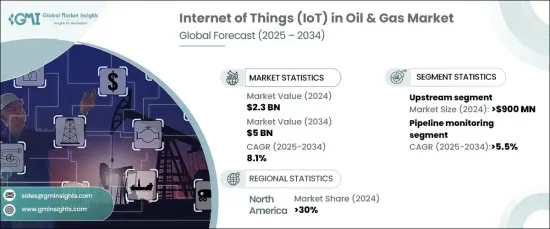
세계의 석유 및 가스용 사물인터넷 시장은 2024년 23억 달러에 달하며, 2025-2034년에 CAGR 8.1%로 성장할 것으로 예측됩니다. 실시간 모니터링, 업무 효율성 및 안전 대책 개선에 대한 관심이 높아지면서 이 산업에서 IoT 기술 채택을 촉진하는 주요 요인으로 작용하고 있습니다.

석유 및 가스 분야의 기업은 자산관리 강화, 생산 공정 간소화, 환경 규정 준수 향상을 위해 IoT 솔루션을 도입하고 있습니다. 이러한 기술이 운영에 통합됨에 따라 전략적 파트너십을 통해 업계내 다양한 기능에 대한 도입이 가속화되고 있으며, IoT 용도는 실시간 데이터 수집, 원격 모니터링, 예지보전을 가능하게 함으로써 운영에 혁명을 일으키고, 운영 성과와 안전 기준을 향상시키고 있습니다. 운영의 성능과 안전 기준을 향상시키고 있습니다. 이러한 발전을 통해 기업은 잠재적인 문제를 조기에 발견하고 위험을 줄이며 다운타임을 최소화할 수 있습니다.
| 시장 범위 | |
|---|---|
| 시작연도 | 2024년 |
| 예측연도 | 2025-2034년 |
| 시작 금액 | 23억 달러 |
| 예상 금액 | 50억 달러 |
| CAGR | 8.1% |
또한 그린 테크놀러지과 지속가능성에 대한 관심이 높아지면서 석유 및 가스 사업에서 IoT 도입이 가속화되고 있습니다. 환경 문제에 대한 우려와 규제 압력이 증가함에 따라 에너지 사용을 최적화하고 배출량을 추적하기 위한 IoT 솔루션에 대한 관심이 높아지고 있으며, IoT 기술은 가스 누출과 같은 위험을 감지하고 환경에 미치는 영향을 모니터링하여 지속가능한 관행에 기여하고 있습니다. 이는 운영 비용 절감뿐만 아니라 에너지 효율성, 이산화탄소 배출량 감소, 장기적인 지속가능성 등 다양한 목표에 부합합니다.
친환경적인 관행으로의 전환을 지원하는 IoT는 보다 친환경적이고 지속가능한 비즈니스를 추진하는 데 있으며, 중요한 역할을 할 것입니다. 그린 테크놀러지 시장은 2032년까지 연간 19% 이상의 견고한 성장률을 보이며 큰 매출을 창출할 것으로 예상됩니다. 이러한 성장은 석유 및 가스 부문에서 지속가능성에 대한 중요성이 커지고 있음을 보여줍니다.
2024년에는 시추 및 시추 작업 모니터링에 대한 IoT 솔루션에 대한 수요에 힘입어 업스트림 부문이 상당한 점유율을 차지할 것으로 예상되며, IoT 장비는 장비 상태, 시추 상태, 시추 효율성에 대한 실시간 인사이트을 제공하여 탐사 및 생산 공정을 강화할 수 있습니다. 인사이트을 제공하여 탐사 및 생산 공정를 강화합니다.
중류 부문도 큰 성장이 예상되며, IoT 기술은 파이프라인 모니터링, 저장 및 운송 시스템을 강화할 것입니다. 이러한 솔루션은 실시간 데이터 수집을 가능하게 하고, 파이프라인의 무결성을 향상시키며, 누출 위험을 감소시킵니다.
석유 및 가스 IoT 시장은 용도 측면에서 파이프라인 모니터링, 차량 및 자산관리, 시추 및 유정 관리, 생산 최적화, 환경 모니터링, 안전 관리 등을 포함합니다. 그 중에서도 파이프라인 모니터링은 안전하고 효율적인 파이프라인 운영을 유지하기 위한 실시간 모니터링 및 예측 분석에 대한 수요 증가로 인해 견고한 성장이 예상됩니다.
북미는 석유 및 가스 분야의 IoT 시장을 선도하고 있으며, 2024년 세계 매출의 대부분을 차지하고 있습니다. 이 지역의 강력한 석유 및 가스 인프라는 디지털 기술에 대한 막대한 투자와 함께 자산관리, 안전 및 파이프라인 모니터링을 위한 IoT 솔루션의 채택을 촉진하고 있습니다.
The Global Internet Of Things In Oil And Gas Market was valued at USD 2.3 billion in 2024 and is projected to grow at a CAGR of 8.1% from 2025 to 2034. The increasing focus on real-time monitoring, operational efficiency, and improved safety measures are key factors driving the adoption of IoT technologies in the industry.

Companies in the oil and gas sector are embracing IoT solutions to enhance asset management, streamline production processes, and ensure better environmental compliance. As these technologies become more integrated into operations, strategic partnerships are helping speed up their implementation across various functions within the industry. IoT applications are revolutionizing operations by enabling the collection of real-time data, remote monitoring, and predictive maintenance, which in turn boosts operational performance and safety standards. These advancements allow companies to detect potential issues early, reducing risks and minimizing downtime.
| Market Scope | |
|---|---|
| Start Year | 2024 |
| Forecast Year | 2025-2034 |
| Start Value | $2.3 Billion |
| Forecast Value | $5 Billion |
| CAGR | 8.1% |
Moreover, the growing emphasis on green technologies and sustainability is accelerating the adoption of IoT in oil and gas operations. As environmental concerns and regulatory pressures intensify, the sector is increasingly turning to IoT solutions to optimize energy usage and track emissions. IoT technologies also help detect hazards, such as gas leaks, and monitor environmental impacts, contributing to sustainable practices. This not only reduces operational costs but also aligns with broader goals for energy efficiency, carbon footprint reduction, and long-term sustainability.
The IoT's role in promoting greener, more sustainable operations is significant, as it supports the industry's transition to eco-friendly practices. The green technology market is projected to generate substantial revenue by 2032, reflecting a robust annual growth rate of over 19%. This expansion highlights the growing importance of sustainability in the oil and gas sector.
The market is segmented based on operations into upstream, midstream, and downstream. In 2024, the upstream segment held a substantial share, driven by the demand for IoT solutions in monitoring drilling and well operations. IoT devices provide real-time insights into equipment health, well conditions, and drilling efficiency, enhancing exploration and production processes.
The midstream segment is also expected to see significant growth, with IoT technologies enhancing pipeline monitoring, storage, and transportation systems. These solutions enable real-time data collection to improve pipeline integrity and reduce the risk of leaks.
In terms of applications, the IoT in oil and gas market includes pipeline monitoring, fleet and asset management, drilling and well management, production optimization, environmental monitoring, safety management, and more. Among these, pipeline monitoring is expected to grow at a robust pace due to the increasing demand for real-time monitoring and predictive analytics to maintain safe and efficient pipeline operations.
North America is leading the IoT market in oil and gas, accounting for a significant portion of global revenue in 2024. The region's strong oil and gas infrastructure, combined with substantial investments in digital technologies, is driving the adoption of IoT solutions for asset management, safety, and pipeline monitoring.